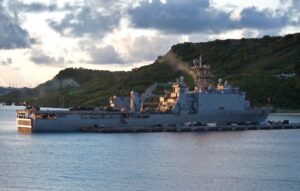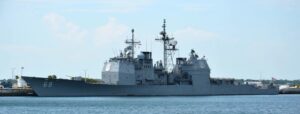The Navy released its annual inactivation schedule message last week, listing 29 ships it plans to inactivate and decommission in fiscal year 2023, barring intervention from Congress.
The list includes two Los Angeles
-class submarines, five Ticonderoga-class cruisers (CGs), nine Freedom-variant Littoral Combat Ships (LCSs), four Whidbey Island-class dock landing ships (LSDs), and several other Military Sealift Command roll on/roll off cargo ships, replenishment oilers, Expeditionary Transfer Dock ships (ESDs), and Cyclone-class patrol ships.

This is in line with the Navy’s fiscal year 2023 budget request that included plans to retire 23 ships in 2023 as part of an effort to save up to $3.6 billion over the next five years (Defense Daily, April 25).
Among the combat vessels, the list includes many ships Congress is currently considering preventing the Navy from retiring, particularly the Ticonderoga-class cruiser USS Vicksburg (CG-69), which has been undergoing modernization work at BAE Systems since 2020.
The Senate’s version of the National Defense Authorization Act (NDAA) bill includes a provision preventing the Navy from retiring 12 ships on this list in FY ‘23 including the USS Vicksburg (CG-69), five Freedom-variant LCSs, all four LSDs on the Navy’s list, and the two ESDs (Defense Daily, June 16).
The Senate NDAA was approved by the Senate Armed Services Committee but has not yet been voted on in the full Senate.
The House’s version of the authorization bill also included a provision preventing the retirement of the USS Vicksburg (CG-69), Germantown (LSD-42), Gunston Hall (LSD-44), Tortuga (LSD-46) and Ashland (LSD-48) (Defense Daily, June 7).
The House Armed Services Committee then added an amendment to the bill increasing the defense bill topline by $37 billion and singled out five of the LCSs to be kept from early retirement (Defense Daily, June 22).
Separately, the House’s defense appropriations bill would keep the Navy from retiring the USS Fort Worth (LCS-3), Wichita (LCS-13), Billings (LCS-15), Indianapolis (LCS-17), and St. Louis (LCS-19) and would allow the Navy to look into transferring four other LCSs allowed to be decommissioned to partner countries (Defense Daily, June 14).
The LCSs were expected to have a service life of 25 years, but the Navy is seeking to decommission them due to a combination of canceling the anti-submarine warfare mission package they were originally set to field and the cost of fixing the combining gear of already delivered ships.
The Navy previously argued the cruisers are on average 35 years old and the higher than expected cost of repairing their poor material condition is better spent on other priorities. This is in contrast to the service’s previous plans to modernize 11 of the remaining 22 cruisers to keep them operational into the 2030s. Now the Navy plans to retire all of the cruisers over the next five years.
The service previously got permission from Congress to decommission the USS Monterey (CG-61), Hué City (CG-66), Anzio (CG-68), Vella Gulf (CG-72) and Port Royal (CG-73) in FY ‘22.

Vice Adm. Scott Conn, Deputy Chief of Naval Operations for Warfighting Requirements and Capabilities, N9, told reporters in April he was skeptical whether the remaining cruiser modernizations will be completed due to difficulties and delays in the work. The USS Gettysburg (CG-64) previously did complete work and was delivered back to the Navy, but Conn was unsure if Vicksburg would meet its expected delivery date (Defense Daily, April 25).
Then, in May, Jay Stefany, principal civilian deputy to the Assistant Secretary of the Navy for Research, Development and Acquisition, confirmed at a House Armed Services Seapower subcommittee hearing that despite being on the decommissioning list, Vicksburg and Whidbey Island-class dock landing ship USS Tortuga (LSD-46) were currently in their modernization maintenance availabilities. Stefany said at the time CG-69 was about 85 percent complete while LSD-46 was close to that level too (Defense Daily, May 19).
According to the list, the Navy plans to start decommissioning in fiscal year 2023 with the USNS Bob Hope (T-AKR 0300) and USNS Fisher (T-AKR-301) cargo vessels and the USNS Walter S Diehl (T-AO-193) replenishment oiler on Oct. 31, 2022. The final ships to be decommissioned include the USS Gunston Hall (LSD-44) on Sept. 29, 2023 and USS St. Louis (LCS-19) on Sept. 30, 2023.
The list noted the five retiring Cyclone-class patrol ships are set to be used as Foreign Military Sales in February and March 2023. This includes the USS Hurricane (PC-3), Monsoon (PC-4), Sirocco (PC-6), Chinook (PC-9) and Thunderbolt (PC-12).